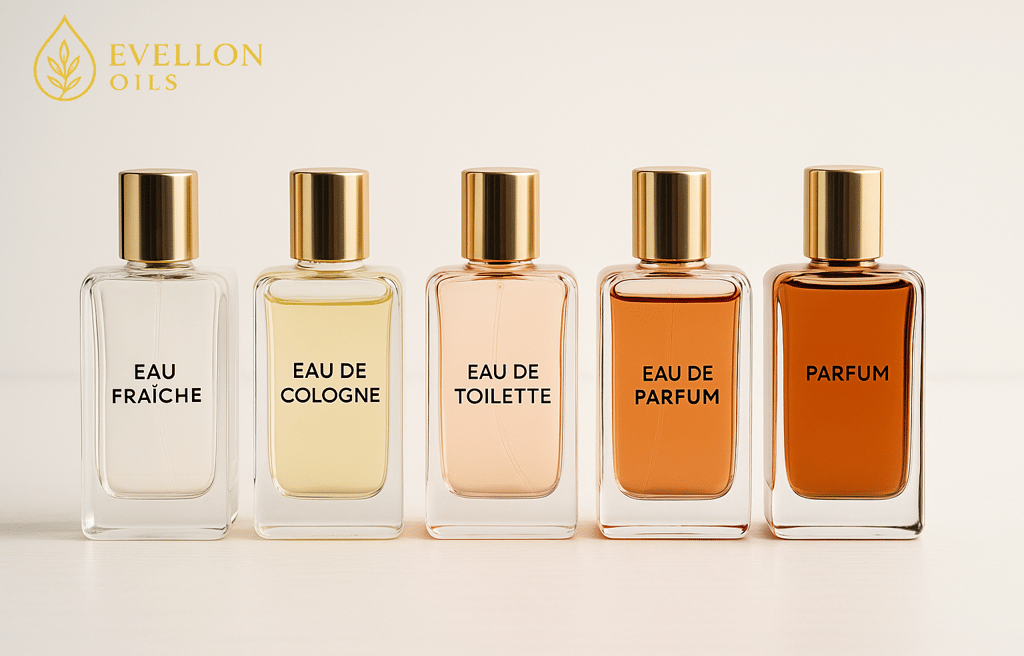Do you know the difference between cologne and perfume? The 5 types of fragrance explained
We explain the 5 types of fragrance. The Eau Fraîche, Eau de Cologne, Eau de Toilette, Eau de Parfum, and pure Parfum.
THE SCENT DAILY
6/12/20256 min read


Ever wondered why some scents vanish before your coffee cools while others linger until sunrise? The answer is actually pretty intuitive. We can simplify the mechanism that governs this longevity of fragrance as a function of the concentration of perfume oil within it. In lieu of this, the industry has settled into categorizing fragrances by their respective concentration. In general, fragrances are divided into 5 categories based on their strength, namely Eau Fraîche, Eau de Cologne, Eau de Toilette, Eau de Parfum, and pure Parfum. Learning how to choose the right concentration is actually a pretty important skill when deciding when to a apply what type of fragrance for different occasions.
Eau Fraîche (1-3 %, lasts about 1 hour)
Eau Fraîche contains the lowest proportion of perfume oils in any fragrance category, resulting in a discreet, quickly evaporating scent. This makes sense as the term literally translate to "fresh water" in English. Its composition then, as expected, is predominantly water with minimal alcohol and aromatic compounds. So, it provides only a brief impression of cleanliness without really creating a perceptible trail. This concentration is appropriate when only a light, temporary freshness is required, such as immediately after exercise, during very warm weather, or in environments that restrict strong fragrances. Frequent reapplication is a must if your looking to smell like the fragrance for a prolonged period of time.
This type of fragrance is optimal for:
Post-workout cooldowns
Super-hot, humid conditions
Scent restricted offices or classrooms
If you're wondering as to why Eau Fraîche is good for super-hot conditions, it's because during hot weather, the evaporation of water and alcohol in the fragrance is accelerated. This means that more of that volatile aroma molecules are released into the air. Thus, something light like Eau Fraîche is perfect as it won't be too strong, yet also enough to deliver that right amount of freshness that doesn't overpower the whole room.
Eau de Cologne (2-5 %, about 2 hours)
Cologne was born in 18th-century Germany as a zingy mix of lemon, neroli, and herbs. Modern versions still lean bright and breezy. It occupies the next step of the concentration scale in the 5 categories. Often times, cologne uses a little more perfume oil that Eau Fraîche types, which means a scent that projects slightly more yet remains restrained and short-lived. It can be described as crisp and quick. Something that suits early-day use, quick errands, and workplace settings where a subtle aromatic presence is acceptable but prolonged overpowering fragrance is not.
Uniquely, because cologne fades within a couple of hours, it can serve as an initial bright layer beneath a longer-lasting fragrance applied later in the day. Many perfume enthusiasts actually exploit this property, using cologne as an aromatic “primer” in the morning: a sparkle of bergamot and neroli jump-starts the senses, then quietly yields to a richer Eau de Parfum applied at lunchtime or before an evening engagement. Because the top-note profiles of traditional colognes stay within the citrus-aromatic palette, they seldom clash with deeper woods, resins, or florals introduced later in the day. However, you have to be a little careful with this. Make sure you know whether your cologne is a type that doesn't mix with the under-layer of stronger perfume. A wrong move, and you could smell like a mess for the day.
It is also worth dispelling the lingering idea that cologne is inherently masculine. The term originated as a technical descriptor for strength, not gender, and for much of its three-hundred-year history it was prescribed indiscriminately to both men and women. The twentieth-century marketing that painted cologne as “for men” and perfume as “for women” has little to do with olfactory science and everything to do with retail positioning. In fact, international fragrance regulatory bodies (IFRA, ISO) define “cologne” strictly by composition, with no reference to target gender. Some of the best-selling “colognes” are explicitly unisex or marketed toward women (e.g., Hermès Eau de Rhubarbe Écarlate, Atelier Cologne’s citrus series).
Eau de Toilette (4-15 %, about 4 hours)
Eau de Toilette (EDT) generally contains between four and fifteen percent perfume oil dissolved in alcohol. It provides a moderate projection and a lifespan of roughly three to four hours on skin. This concentration is calibrated to deliver a discernible yet understated presence. What we mean by this is that it opens with recognizable top notes, transitions through a well-articulated heart, and settles into a light base without overstaying its welcome. For this reason, many fragrance houses introduce new compositions in EDT first, using its balanced strength as a benchmark to test market acceptance.
In practical terms, EDT is well-suited to professional and social environments where a noticeable but non-intrusive scent is desirable. For example, office meetings, daytime appointments, informal dinners, and occasions where subsequent reapplication is feasible. Its moderate oil load also accommodates seasonal variation: citric or marine EDTs remain comfortable in summer heat, while woody or spicy versions maintain clarity in cooler air without becoming oppressive.
To obtain consistent performance, apply EDT to wrists, neck, and, when appropriate, the collar of a garment. Fabric can extend longevity by slowly releasing absorbed molecules, though care should be taken with delicate materials prone to staining. Because its sillage diminishes gradually rather than abruptly, EDT can function as an adaptable platform for layering; a later application of Eau de Parfum or Parfum can deepen the profile without olfactory conflict (similar to cologne, but make sure you know there are no conflicting scents!).
Eau de Parfum (15-20 %, about 5 hours)
Eau de Parfum (EDP) carries a perfume-oil concentration of approximately fifteen to twenty percent, affording it a noticeably longer lifespan. It definitely has a more substantial presence than Eau de Toilette. The higher oil content stabilizes the composition, allowing mid-notes and base materials to develop fully while tempering the volatility of the top accords. Projection remains measured: usually sufficient to mark personal space without dominating a room under correct application.
This concentration proves effective in environments where endurance and nuance are required—formal meetings, evening engagements, or climates that diminish lighter scents. The richer formula excels in cooler temperatures, where it unfolds gradually rather than dispersing sharply which is why it is often suited for formal occasions that are often times cool.
Two to three controlled sprays on pulse points are generally adequate. Excess application can lead to saturation, as the denser matrix binds readily to skin lipids and textiles. When layering, EDP is best placed after lighter products—such as an unscented moisturizer or a brief morning cologne—so that its development remains uninterrupted.
Parfum (20-40 %, ranges from 8-24 hours)
Parfum contains roughly twenty to forty percent perfume oil, the highest concentration used in commercial perfumery. The high density here yields scents that can last for eight hours or more, some even up to 24 hours. Typically, Parfum permits the use of more complex materials like resins, absolutes, and rare florals. If using this, you should apply is as a dab or a controlled micro-spray, as even a fractional milliliter deposits quite a strong aromatic load onto the skin.
Because the composition is both rich and tenacious, Parfum is most effective in settings where sustained, close-range presence is appropriate. For instance, formal evening events, cool climates, or circumstances in which reapplication is impractical. Its lower alcohol content also reduces initial volatility, causing the fragrance to sit closer to the wearer and develop gradually, which can be advantageous in confined spaces where stronger projections might be a little too much.
Dosing discipline is essential when dealing with Parfum. A single drop on a pulse point, or, alternatively, a quick touch to fabric unlikely to stain—usually suffices. Excessive use will lead to olfactory fatigue for both wearer and bystanders, as the base materials bind readily to skin lipids and textiles. When incorporated thoughtfully, however, Parfum delivers the most faithful, enduring expression of a perfumer’s design. It also allows perfume designers a lot of freedom to design the scent, which means you are essentially allowing them to present the fragrance exactly as they envisioned it to be.
Summary
In short, the five types of fragrances all have their own uses. Learning when to reach for which one ensures you’ll leave the right impression everywhere you go. We have summarized some of the main points below:
Eau Fraîche – A whisper of scent: mostly water with just a trace of perfume oil, perfect for a quick, refreshing lift that fades fast.
Eau de Cologne – Bright citrus and herbs that sparkle for a couple of hours, ideal for morning errands or a mid-day reset.
Eau de Toilette – The everyday workhorse: balanced projection and three-to-four-hour staying power, adaptable to most settings.
Eau de Parfum – Richer, more layered, and built to last through a full afternoon or evening without overwhelming the room.
Parfum – The purest form: dense, nuanced, and long-wearing—one drop delivers the perfumer’s vision for an entire day.




